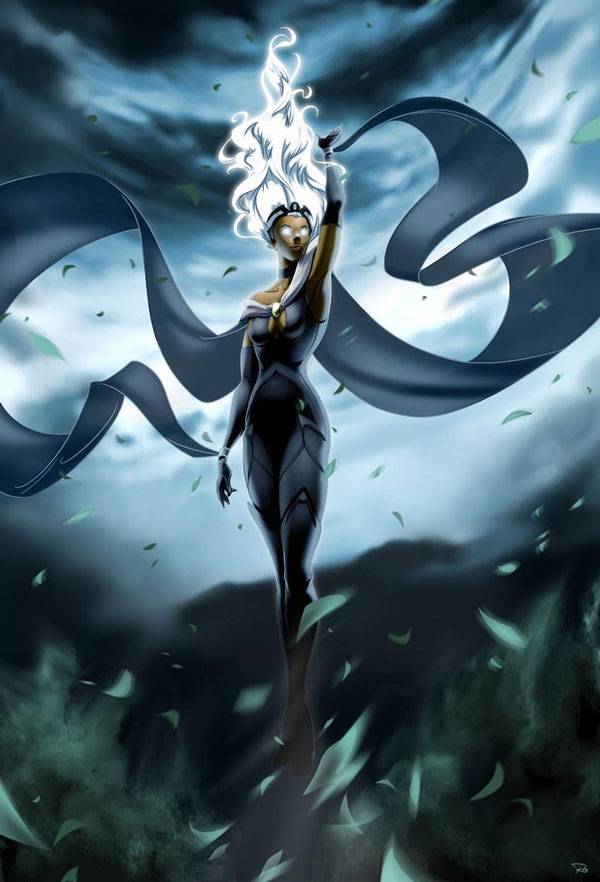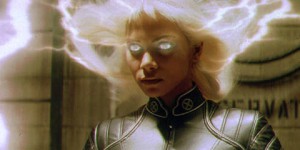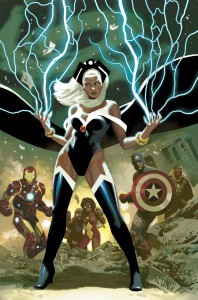First Appearance
Giant-Size X-Men #1
Nicknames and Aliases
‘Ro, Windrider, Goddess
Powers and Abilities
Storm is a mutant with the ability to control and manipulate the weather, including the creation of localized lightening for personal attacks and the generation of winds to enable flight. Her power gives her a deep and spiritual connection to Earth.
In addition to her mutant powers, Storm is an accomplished thief, lockpick and escape artist, having trained since early childhood under Cairo’s master thief. She is also an accomplished leader and battle tactician.
Weakness and Achilles’ Heel
Storm suffers from acute claustrophobia, a result of the childhood incident in which she was trapped in the rubble of a building during an attack which killed her parents.
Gadgets and Accessories
Storm often wears a cape designed to assist her in “riding the winds” she creates to fly, and she conceals lock picks and other such devices on her person, such as the inside lining of her headdress.
Friends and Allies
Black Panther (T’Challa, her ex-husband), Shadowcat (Kitty Pryde, her surrogate daughter), Forge (her one-time lover) the Morlocks (a group of mutants living in tunnels beneath Manhattan), Callisto, Yukio, the X-Men, the Avengers.
Foes and Antagonists
Magneto, the Shadow King, Dracula, Apocalypse, Mr. Sinister, the Brotherhood of Evil Mutants, anti-mutant prejudice and intolerance, closets.
Movies and Appearances
Storm was a mainstay of the 90s X-Men animated series, voiced with a level of at-times comical grandiosity, and continues to appear in most animated adaptations of the X-Men.
She was played by Oscar winner Halle Berry in four X-Men films (sitting out First Class), and Alexandra Shipp will take up the role in the upcoming X-Men: Apocalypse.
One Sentence Origin
Orphaned at a young age and raised by a thief on the streets of Cairo, Storm’s mutant powers led to her being worshiped as a goddess in Kenya before she was recruited by Professor X to join the second generation of X-Men.
Memorable Moment
After an outer space jaunt that found her connection to Earth’s ecosystem strained and an encounter with the free-spirited Yukio in Japan, the restrained Storm cuts loose, trading in her traditional look for leathers and a mohawk.

Storm is an amalgam of two characters designed by artist Dave Cockrum prior to the release of Giant-Size X-Men #1, the female Black Cat and the male Typhoon. Faced with the recent launch of other cat-like characters, editor Roy Thomas suggested Cockrum make Typhoon the female member of the All New X-Men and he adapted the Black Cat image to that end.
Austin’s Analysis
Storm, easily Marvel’s most high-profile female African-American character (and of the first such characters in superhero comics), is a character whose most prominent and well-executed storyline occurred nearly two decades ago. In the mid-80s, longtime X-Men scribe Chris Claremont crafted a long story arc for Storm, which found her shedding her ethereal, goddess-esque image in the face of the burden of leadership and a desire to experience life more fully in favor of a more striking punk look and sensibility. Then, she lost her mutant powers and was forced to prove her worth as leader of the X-Men on her non-superpowered skills alone, a feat she accomplished with aplomb, continuing to lead the X-Men through some of their darkest hours (including the massacre of the Morlocks) before ultimately finding a way to restore her superpowers.
It was a compelling arc for the character, one which unfolded over dozens of issues and several years of publication and which made her one of the most engaging members of a team that also included such fan favorites as Rogue, Kitty Pryde, and Wolverine. Unfortunately, in the years after the restoration of her powers, Storm mostly faded into the background of the X-Men (she died for awhile, then came back as a little kid), and she’s struggled to step out of it ever since.
When all the scattered X-Men were reunited under one banner in 1991, Storm was made leader of one of the two X-Men teams to emerge from the reunification, but the idea of split teams soon faded, and Storm’s prominence faded a bit with it, still a capable leader but rarely getting the kind of juicy or buzzworthy storylines that 90s stalwarts like Rogue, Gambit, and Bishop received. The 90s X-Men cartoon, which put the X-Men in front of a lot of new faces, reinforced the notion of Storm as a secondary (and somewhat boring) character, and Halle Berry sleepwalking through the role in four films did little to showcase the best and most engaging aspects of Storm’s characterization to an even larger audience.
Marvel, to their credit, has tried to raise Storm’s profile in the last decade, first via a ballyhooed marriage to Black Panther (building off an old backup story from the 80s which revealed they had been childhood friends) and later via stints in both the Fantastic Four and the Avengers, as well as an assortment of miniseries, short-run solo series and a female-centric X-Men title. But the character continues to struggle to break out of the background, to stand on her own as more than just a member and occasional leader of the X-Men/Avengers/etc, to get the kind of attention and meaty characterization she received the first time she sported a mohawk.
Which is a shame, as Claremont’s mid- to late-80s examination of the character shows there’s plenty of compelling material to be mined from the thief-turned-goddess-turned-leader of superheroes, and one of comics’ most prominent female African-American characters deserves to reach those heights of characterization again.







